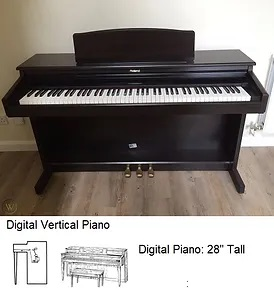Sizes and Types of Pianos
Vertical Pianos: Vertical piano types are classified according to a combination of piano height, cabinet styling, and size and position of action. This illustration shows how the height of the piano dictates the size and position of its action. First, the Upright Grand/Cabinet Grand Piano (52″-60″) is the tallest and heaviest (some weigh 800 lbs) of the vertical pianos The full-size Upright (48″–52″) contains a full-size, extended direct-blow action. The Studio piano (44″–47″) has a full-size, direct-blow action. The Console piano (40″–44″) has a compressed action (notice the smaller action parts), direct-blow type. Last, the Spinet (36″–40″) has a full-size, but indirect-blow action. See text for a discussion of the advantages and disadvantages of each action type. Most domestic vertical actions made in the past hundred years fall into these general categories, but foreign-made pianos may have action parts whose size falls in between two types, and occasional hybrid or unusual actions may defy classification.

Grand Pianos: Unlike vertical pianos, grand pianos differ primarily in their length, and not in the type, size, or position of their actions (except that longer grands generally have longer keys than do shorter grands). Size classification of grands is less standardized than that of verticals, but a common breakdown is: Baby Grand (4′ 6″–5′ 6″), Medium Grand (5′ 6″–6′ 6″), Large Grand (6′ 6″–7′ 6″), and Concert Grand (over 7′ 6″). Historically, many other names have also been applied to grand-piano sizes, such as Petite Grand, Parlor Grand, and Living-Room Grand, but these have no technical or standardized meaning.
